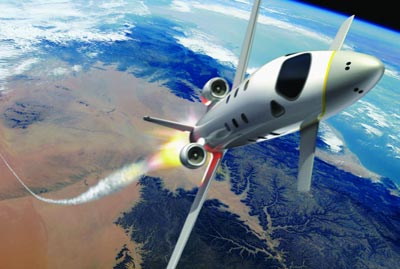From the European garageby Bob Clarebrough
|
| “There are those who think you can design a rocket plane in a garage. Suffice to say that is not our niche,” said Astrium’s CTO. |
Compare this with an article that appeared two weeks later in the New York Times under the headline, “The Amateur Future of Space Travel”, authored by Jack Hitt (who is working on a book celebrating amateurs in America). In that piece, Hitt focused his story on Peter K. Homer, an unemployed engineer who designed the astronaut glove that won a $200,000 prize from NASA. Homer had ruled out the possibility of building a flying spacecraft but decided that “the glove contest represented something of the scale I could achieve working out of my home by myself.” He’d always been a garage tinkerer, he said, and being out of work, he also wanted to prove to his 14-year-old son “that you can do anything if you put your mind to it.” Homer had once worked sewing boat sails and used that experience to develop a radically new method for stitching the glove so as to provide maximum flexibility for the astronaut’s fingers yet maintaining the required integrity of a pressurized spacesuit.
The essential point is that NASA spent loose change to acquire a revolutionary new glove and Homer retains the intellectual property to develop the product in whatever way he chooses—a win-win result. Of course, I’m sure that EADS would agree that this kind of thing is not “their niche.” Come to think of it, is manned space flight their niche, either?
It would be tedious to repeat the list of world-changing innovations that have come out of the American tinkerer’s garage (or bedroom or kitchen). But we can sum it up in two words: Peter Homer. When Europe produces one of those and allows him to flourish it will earn the right to comment. Meanwhile, the American space entrepreneurs, hampered by their lack of “engineering seriousness,” are doing their thing anyway and showing solid results.
And what should we think of Astrium’s own business-model seriousness?
The president of Astrium is forecasting a market of 4,500 suborbital passengers per year at a ticket price of $267,000 generating $1.2 billion in annual revenues. Whether this is the projected European market or the total world market is unclear from the statement. If the latter case is true, then Astrium can expect to get only a share of that $1.2 billion, not all of it. But whichever case is the right one, the assumption regarding ticket price is fanciful for two reasons. First, the American pioneers are united in their determination to make space travel affordable for a mass market and will bring prices down as fast and as far as they can. If I can fly for $20,000, then I will certainly travel to the US to do so rather than pay thirteen times as much to fly from Europe. Second, assuming the cost of a ticket remains at that high price, even the high-rollers may fly only once and there will be no repeat business. Therefore, the European space tourist industry will enjoy just a few years of success before the well runs dry. In summary, low prices will destroy Astrium’s competitiveness; high prices will drastically limit its market. Either way, it is unlikely that it or its co-investors will recoup the massive development costs of the project let alone cover the operating costs of flying (and I’ve deliberately avoided discussing the cost to Europe’s taxpayers of building one or more spaceports and associated infrastructure or the fees that a European spaceline might have to pay to use these facilities!).
There is another worry. Assuming that the money is raised to build Europe’s version of SpaceShipOne (or Two), by the time it enters service it will be up to 10 years behind what Burt Rutan and the rest will be working on. The merely suborbital ship’s introduction may be overtaken by the launch of full orbital flights from the US, perhaps at a ticket price no higher than that assumed in Astrium’s suborbital business plan. Making buggy whips in Henry Ford’s world wasn’t a recipe for success either.
| In summary, low prices will destroy Astrium’s competitiveness; high prices will drastically limit its market. |
Astrium’s plight illustrates the wider picture of Europe’s inability to compete in the global innovation race. Some more evidence: the BusinessWeek-Boston Consulting Group’s annual survey of the world’s 50 most innovative companies includes only eight European firms, of which just three make it into the lower reaches of the top 20. The US, however, dominates the list with 35 companies. For Europe to overcome this sorry state of affairs it needs a better vision than doing things simply because they are either “not American” or “bigger and better than anything they’ve got.” There’s nothing wrong in avoiding slavish imitation or in wanting to do your own spectacular stuff. But being innovative means creating something that offers value customers will pay for. However, Europe’s decision-making criteria inevitably lead to death-or-glory projects that never make any money: witness the commercial disaster that was Concorde, or the Airbus A380 that is fuelled entirely by red ink.
Europe has a wealth of talent yearning to breathe free. So here’s a better way of spending a billion euros. Carve out a large piece of land that is beyond the direct control of national governments or the European Union. Declare this territory to be free of all taxes, duties, and restrictive employment laws. Ban all bureaucrats from ever entering it. Then build as many garages as will fit into the space and turn Europe’s tinkerers loose in them. If they have even half the spirit of the American amateur the results will be breathtaking, fast, and a fraction of the cost.
